Have you ever wondered what images made with AI inspired by different artists look like? Artificial Intelligence (AI) has the ability to create images in a matter of seconds, and in this article, we'll explore how Tess AI, which integrates the world's largest AIs, can replicate iconic artistic styles.
Here are some prompts that can serve as inspiration for different applications. Whether it's to create personalized communication on your company's social networks, interact creatively with your customers or even for educational purposes, AI offers countless possibilities.
Our aim is to help you understand how developing good prompts has a direct impact on the quality and satisfaction of the results of the images generated. We'll show you how AI can be useful due to its adaptability, versatility and innovation. Read on and get inspired!
1. Leonardo da Vinci
Renaissance artist Leonardo da Vinci is famous for his sfumato technique, anatomical precision and innovations. His works stand out for their realism, perspective and subtle use of light and shadow.
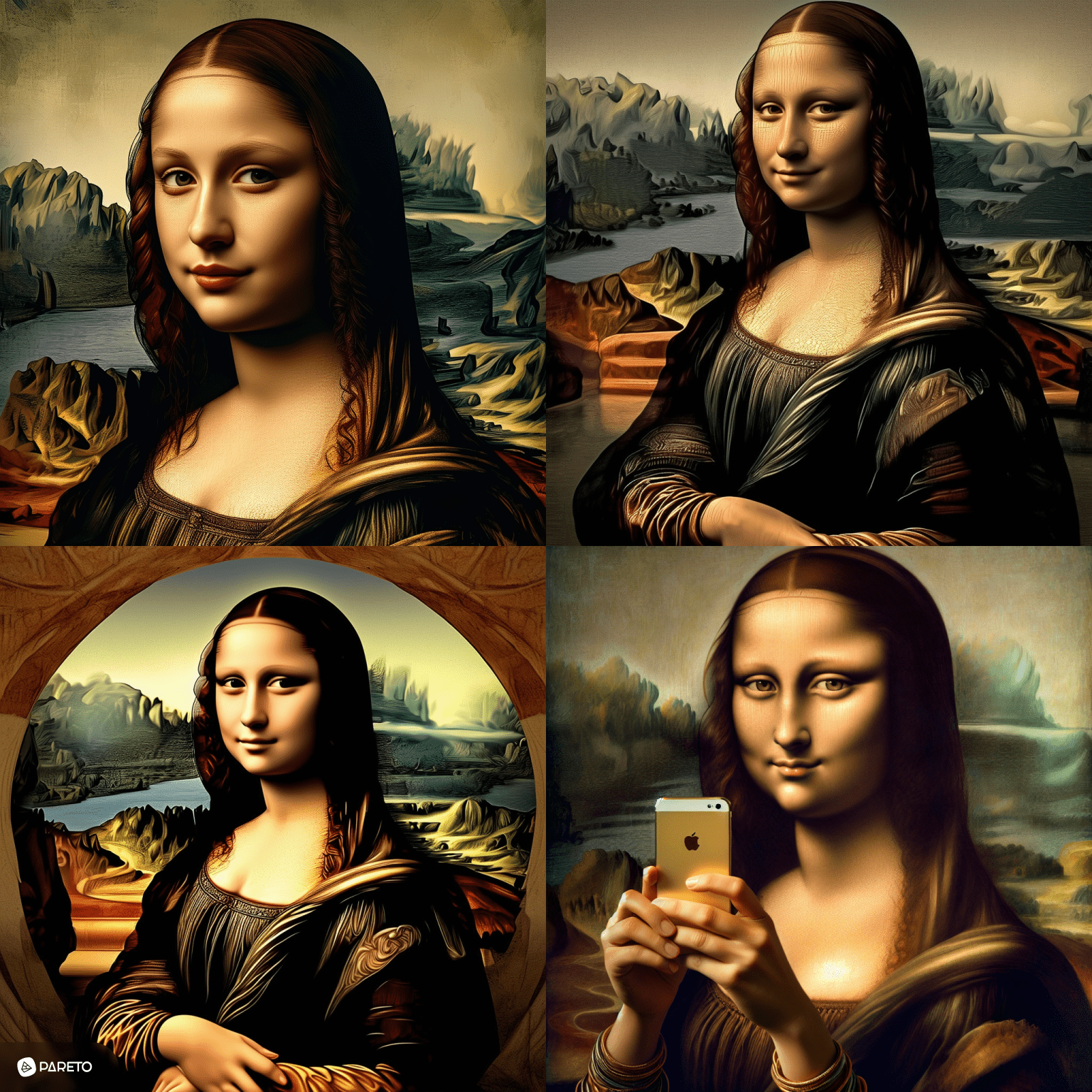
Prompt: "Mona Lisa art inspired by the artist Leonardo da Vinci. Renaissance style, known for its sfumato technique, precise anatomy and innovations. Realism, perspective and subtle use of light and shadow. Skin details".
Prompt: "Mona Lisa art inspired by the artist Leonardo da Vinci. Modern Mona Lisa taking a selfie. Rereading the work. Skin details, good lighting".
Models: Stable Diffusion 3 and DALL-E 3
2. Michelangelo
Renaissance Michelangelo is famous for his monumental sculptures and paintings. His works are characterized by muscular figures, drama and anatomical perfection.
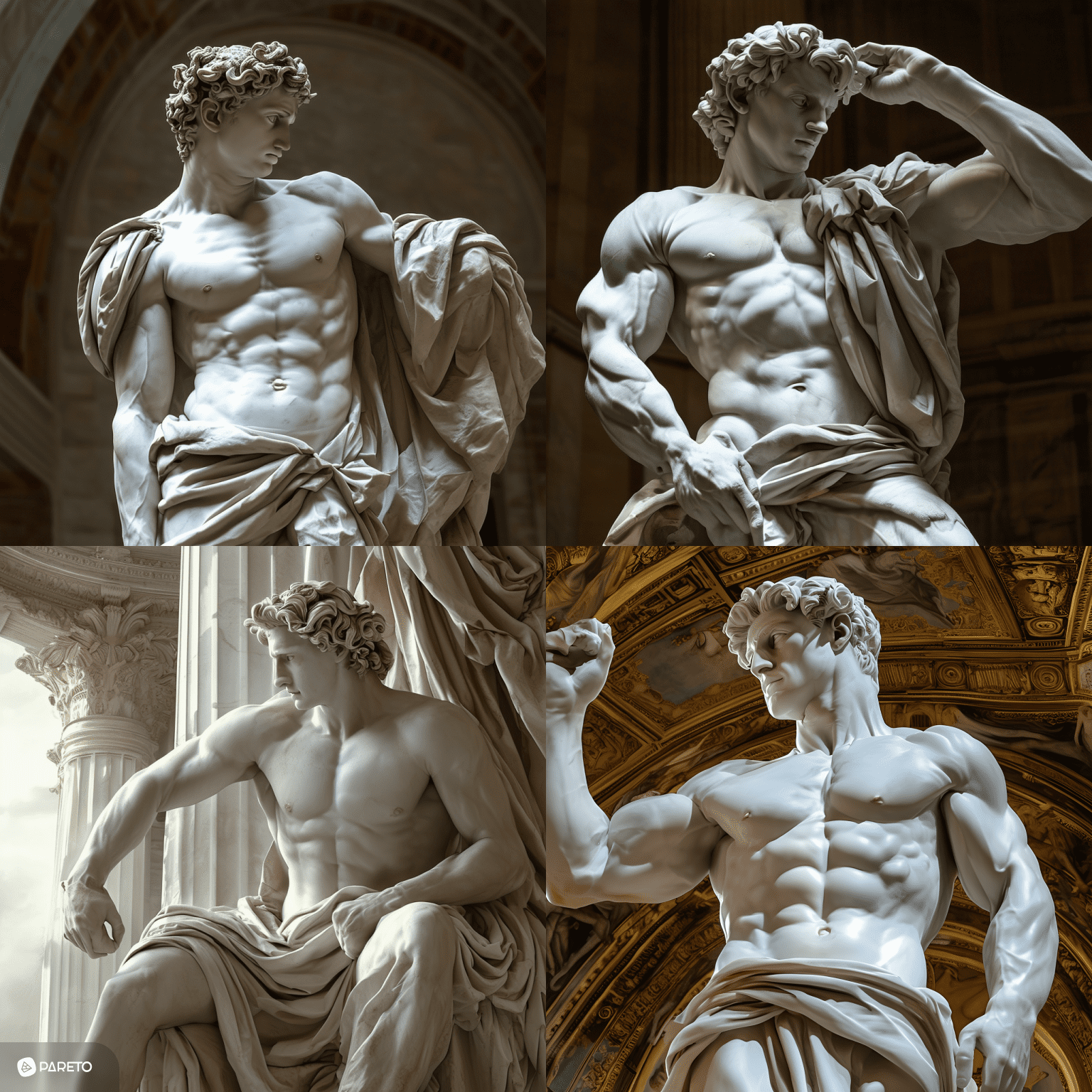
Prompt: "In a Renaissance style inspired by the iconic works of Michelangelo, the scene must feature a monumental and anatomically perfect figure in a dramatic pose. The composition must convey a feeling of grandeur and artistic mastery, with attention to light and shadow. Incorporate classic elements or drapes to enhance the overall aesthetic".
Model: Stable Diffusion 3
3. Pablo Picasso
Pablo Picasso, cubist and surrealist, revolutionized modern art. His works are characterized by geometric shapes, multiple perspectives and bold use of color.
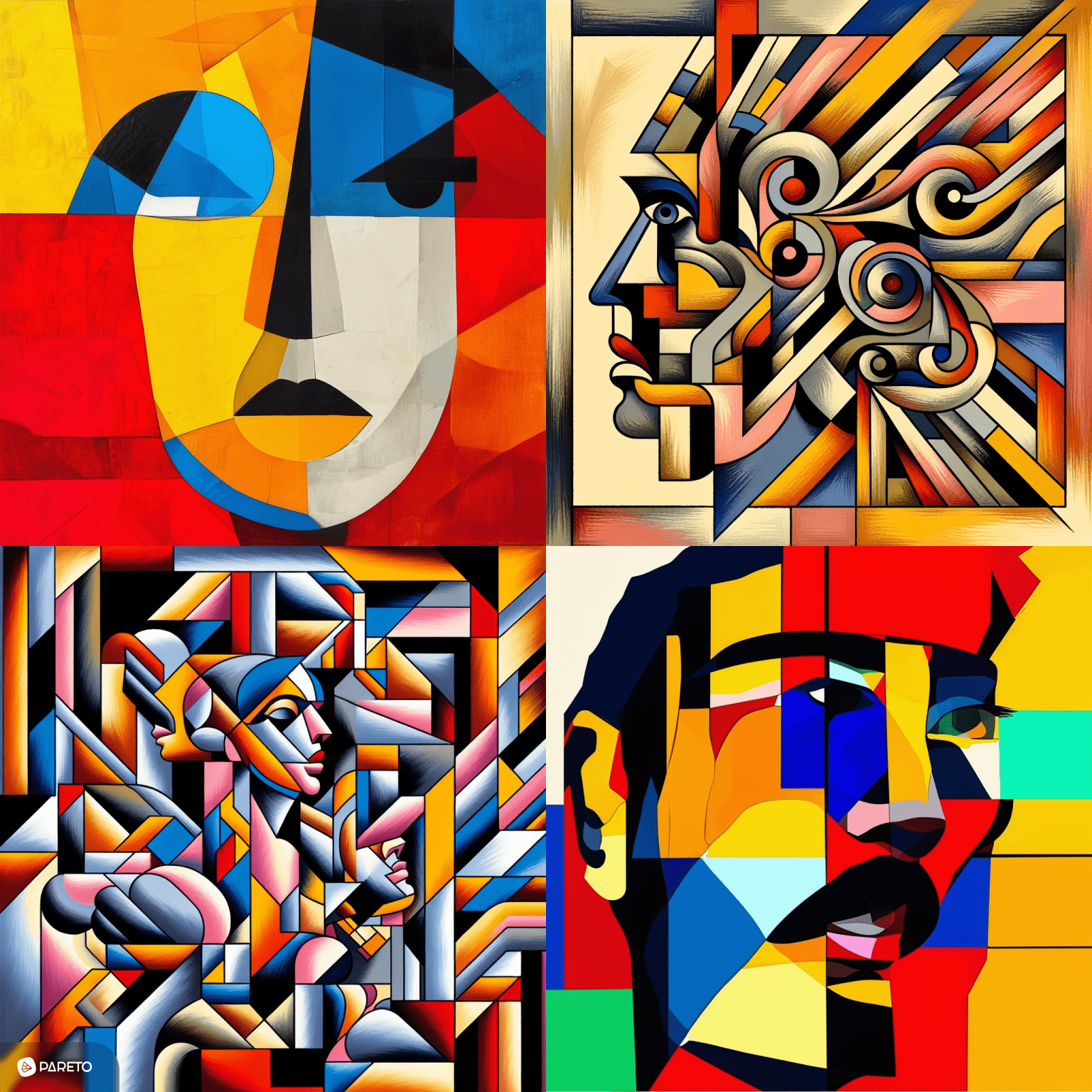
Prompt: "Inspired by Pablo Picasso's iconic cubist and surrealist style, create a composition with bold, fragmented geometric shapes that represent multiple perspectives of the subject simultaneously. It incorporates vibrant and contrasting colors in a bold way. The image must challenge traditional representation, presenting distorted figures or objects that mix reality with abstract elements. The overall composition should evoke the revolutionary spirit of modern art, breaking conventional rules of perspective and representation".
Model: Stable Diffusion 3
4. Vincent van Gogh
Post-impressionist Vincent van Gogh is known for his expressive brushstrokes and vibrant colors. His works are characterized by intense emotion, striking textures and themes from nature.
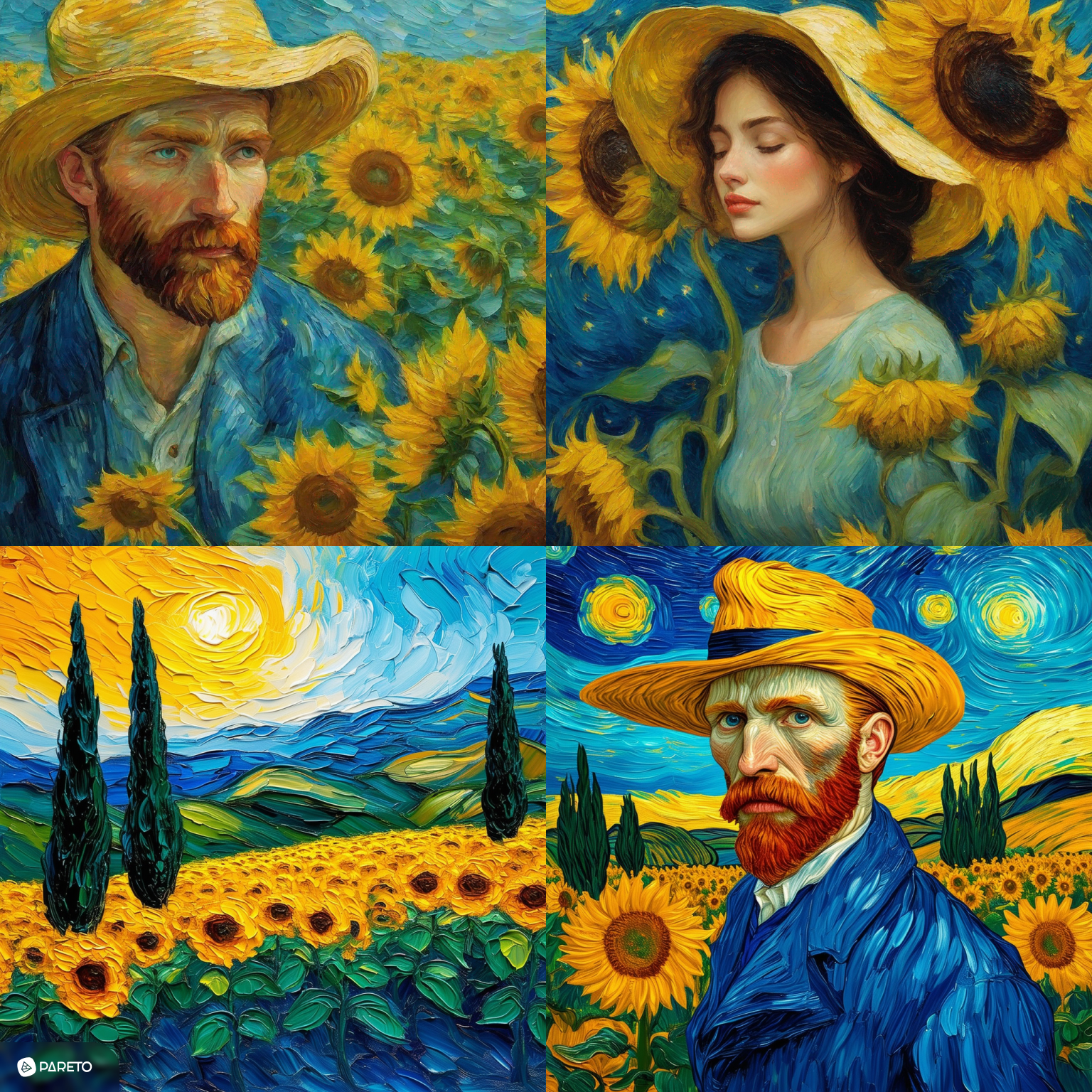
Prompt: "Represent Vincent van Gogh in a landscape with cypress trees wearing a blue suit and yellow hat, in a field of sunflowers and a starry night sky. Incorporate your expressive brushstrokes and vibrant, bold colors. Details on the artist's skin. Use colors such as: rich yellows, deep blues and earthy greens".
Model: DALL-E 3
5. Rembrandt van Rijn
Dutch Baroque artist Rembrandt van Rijn is a master of chiaroscuro (the Italian word for "light and shade" or, more literally, "chiaroscuro"). His works are characterized by the dramatic use of light and shadow, deep psychological portraits and self-portraits.
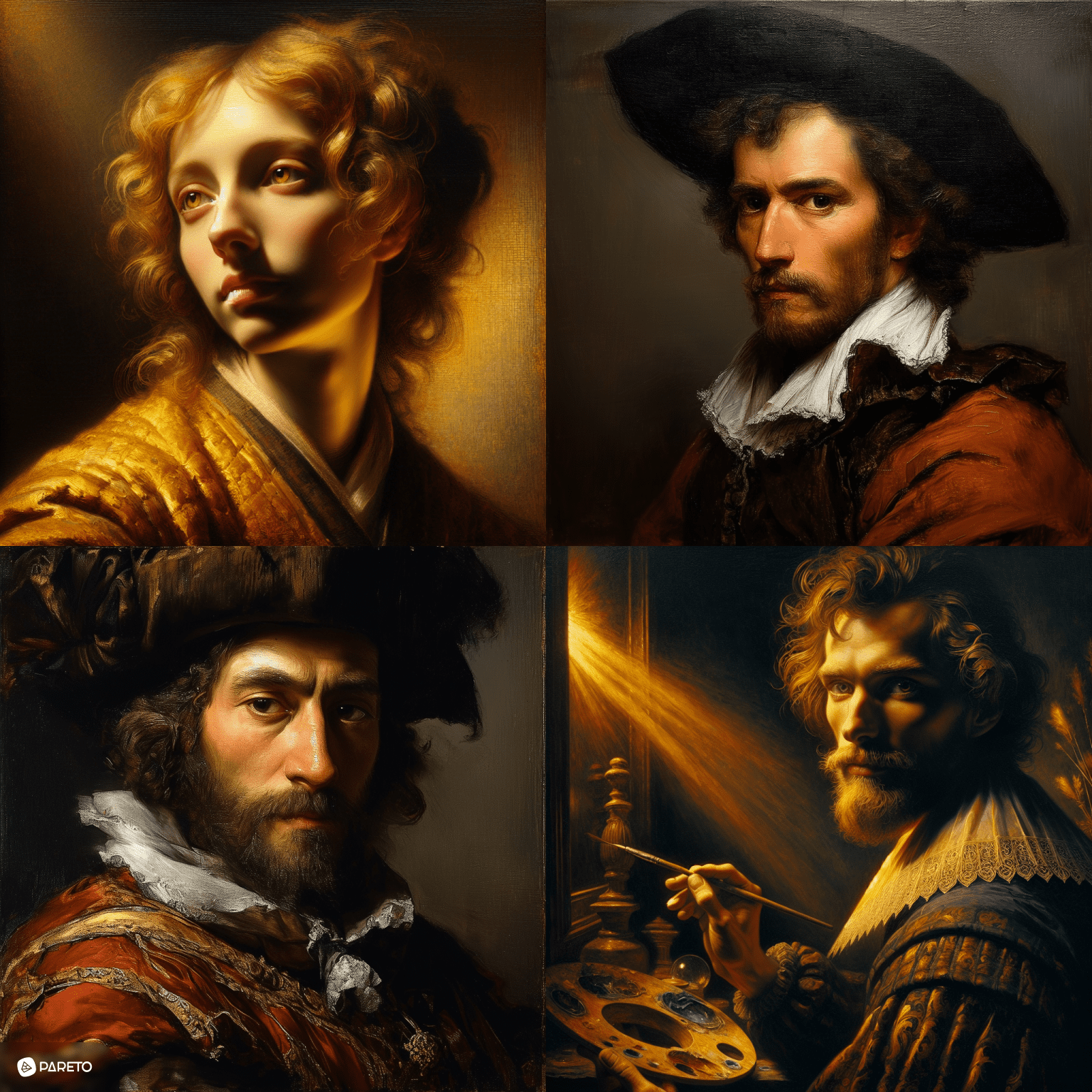
Prompt: "Painting in the style of Rembrandt van Rijn, the Dutch Baroque master. Focus on the dramatic use of chiaroscuro, with intense contrasts between light and shadow. The composition must present a self-portrait with deep psychological complexity, capturing the subject's most intimate thoughts and emotions. Include rich, warm tones typical of Rembrandt's palette, such as deep golds, rich browns, and subtle earth tones. The painting should emerge from a dark background, with areas of the face and clothing highlighted by a strong, directional light source. Pay attention to the intricate details in your subject's expression, clothing textures, and surrounding elements".
Model: Stable Diffusion 3 and DALL-E 3
6. Claude Monet
Claude Monet, an impressionist, was a pioneer in capturing light and atmosphere. His works are characterized by loose brushstrokes, vibrant colors and series of paintings of the same theme.
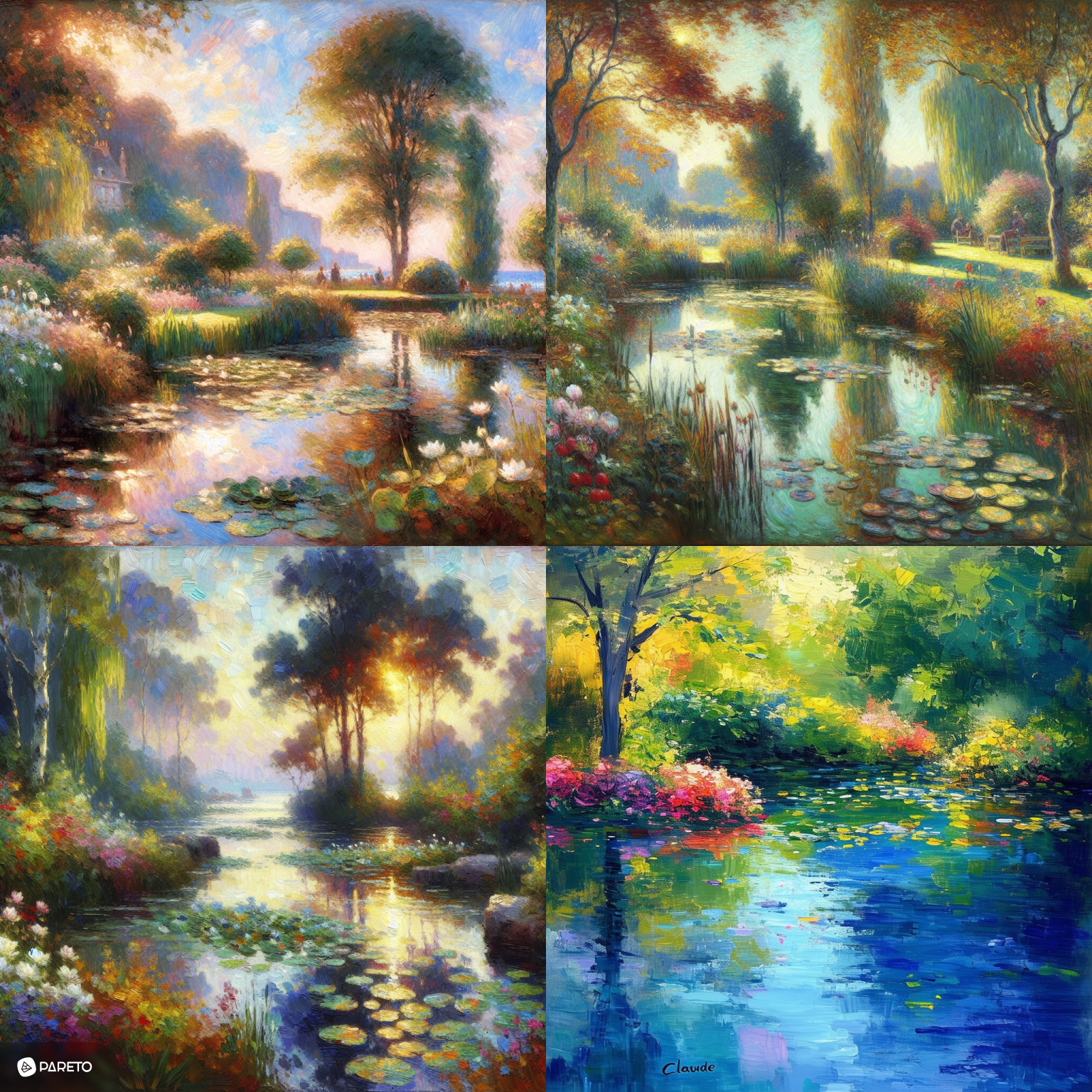
Prompt: "Painting inspired by Claude Monet's impressionist style. Focus on capturing the ephemeral effects of light and atmosphere in a landscape or water scene. Use loose, visible brushstrokes and a vibrant color palette to convey the impression of a fleeting moment. The composition should feature a serene outdoor setting, such as a garden, a lily pond, and a coastal scene bathed in soft, natural light. Emphasize the play of light on surfaces, showing how colors change according to different times of day. Include reflections in the water or the dappled effect of sunlight through trees. Dreamlike, almost ethereal quality, with shapes suggested rather than sharply defined".
Model: DALL-E 3
7. Salvador Dalí
Surrealist Salvador Dalí is known for his dreamlike and bizarre images. His works are characterized by unexpected juxtapositions, complex symbolism and meticulous technique.
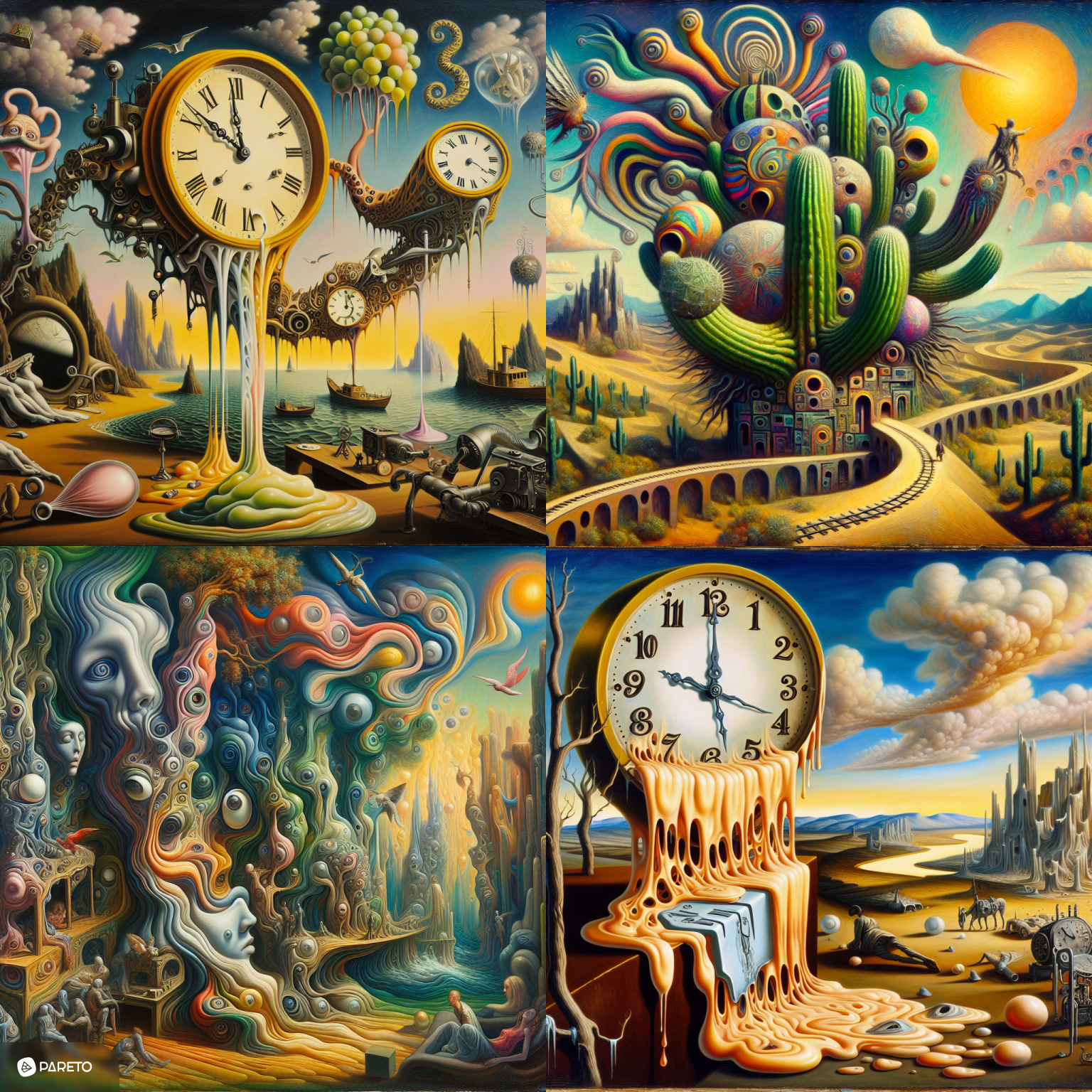
Prompt: "Surrealist painting inspired by the distinctive style of Salvador Dalí. Compose a dreamlike and bizarre scene that defies logic and reality. Incorporate complex symbolism and hidden meanings into image elements. The composition must present hyper-realistic details executed with meticulous technique, contrasting with the surreal nature of the scene. Use a color palette reminiscent of Dalí; work, with vivid tones and dramatic lighting to enhance the otherworldly atmosphere. Include recognizable Dalí motifs, such as elongated figures, anthropomorphic shapes, or distorted perspectives. Mix the familiar with the fantastic".
Model: DALL-E 3
8. Frida Kahlo
Frida Kahlo, a Mexican surrealist and folklorist, is known for her self-portraits. Her works are characterized by personal symbolism, vibrant colors and themes of identity and pain.
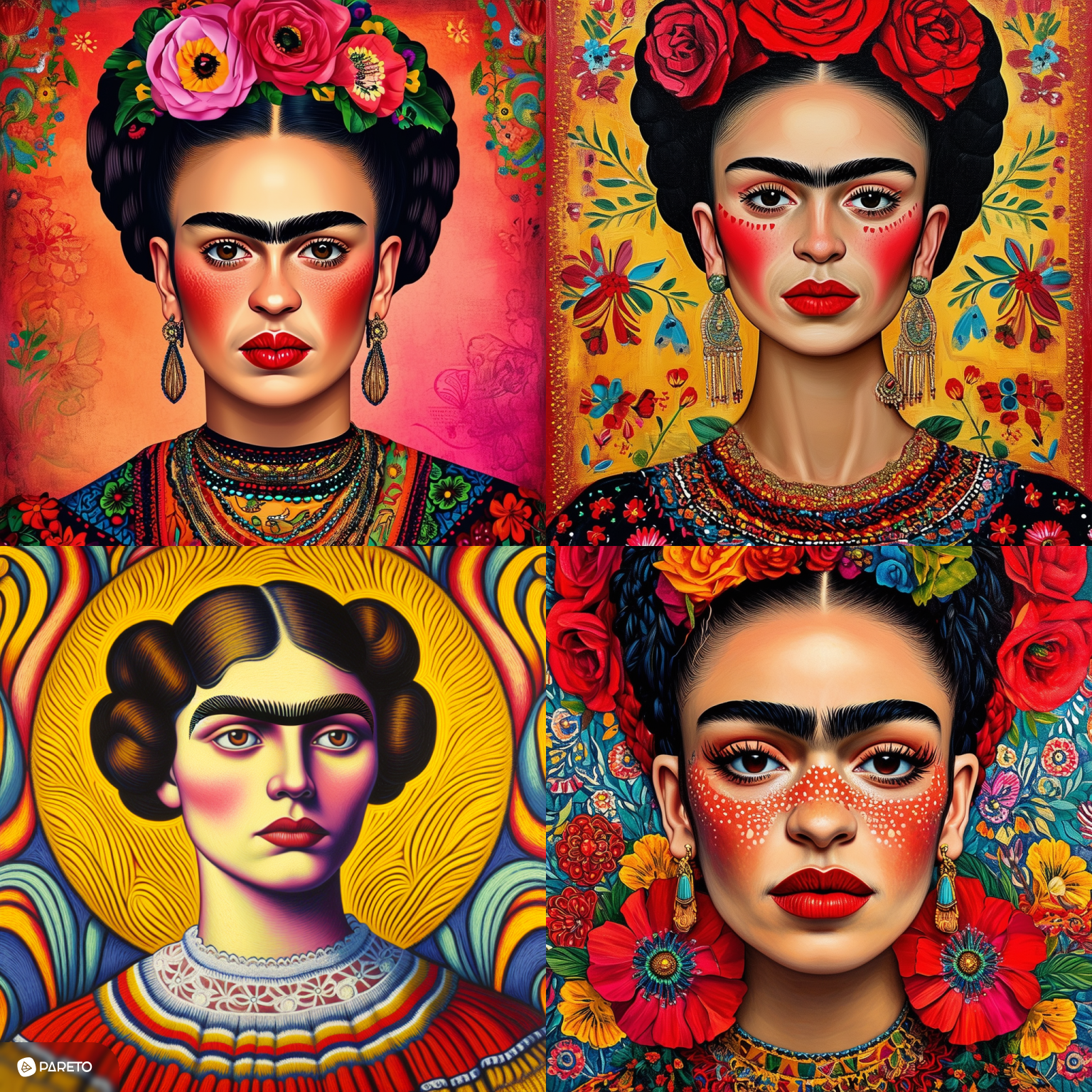
Prompt: "Painting inspired by the surrealist and Mexican folk art style of Frida Kahlo. Self-portrait that embodies her unique vision, featuring a central figure with Kahlo; recognizable features, including her prominent unibrow and traditional Mexican attire. Incorporate vibrant, bold colors typical of Mexican folk art, such as deep reds, bright yellows, and rich blues".
Model: Stable Diffusion 3
9. Andy Warhol
Andy Warhol, Pop Art icon, is famous for his appropriation of images from popular culture. His works are characterized by repetition, bright colors and social commentary.
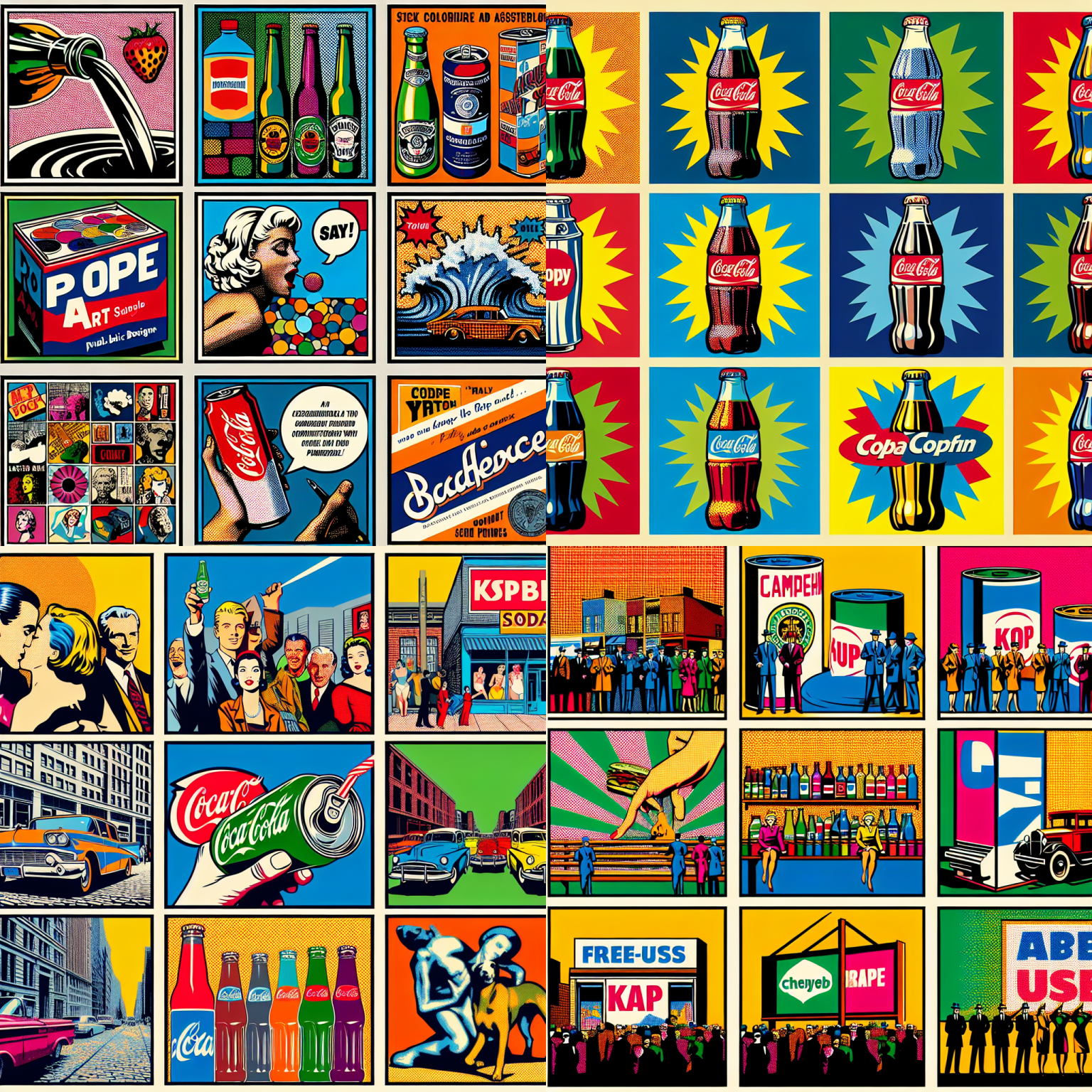
Prompt: "Mosaic with 6 images. Inspired by Andy Warhol; iconic Pop Art style, create a composition featuring a recognizable painting from popular culture, repeated in a grid-like pattern. Use bold, vibrant colors with high contrast, reminiscent of screen printing techniques. Incorporate apartment, simplified shapes and contours to emphasize the commercial, mass-produced aesthetic typical of Warhol's work. Small variations in color or tone, creating a dynamic visual effect. Include elements that suggest consumerism or mass media, such as "Coca-Cola" product logos or advertising slogans. The overall composition should have a striking, attractive quality that is reminiscent of modern society and popular culture".
Model: DALL-E 3
10. Georgia O'Keeffe
Georgia O'Keeffe, an American modernist, is known for her paintings of flowers and landscapes. Her works are characterized by enlarged organic forms, soft colors and abstraction.
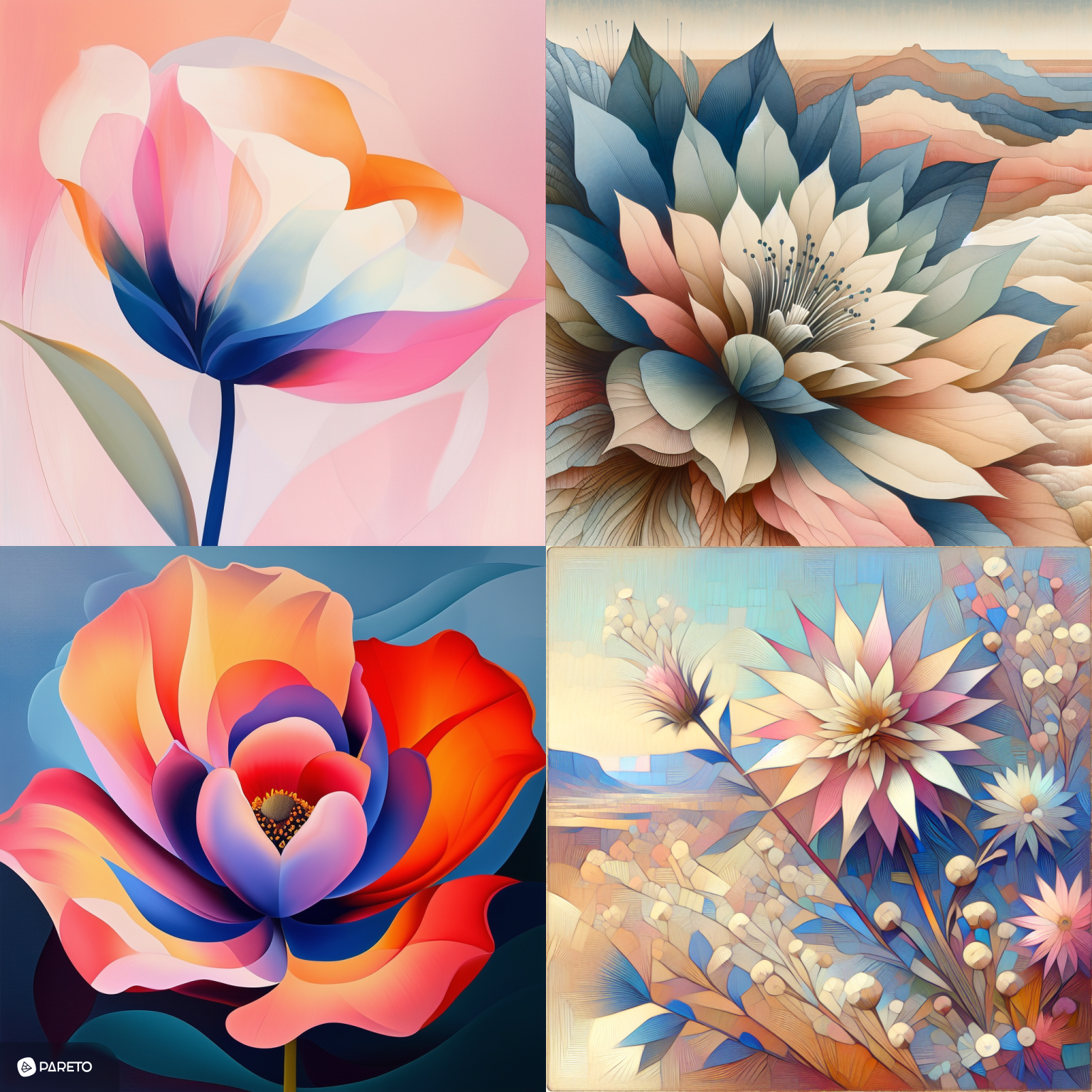
Prompt: "Flower in desert landscape element, inspired by the American modernist style of Georgia O'Keeffe. Use soft and subtle color gradients focusing on pastel tones: blue and pink. Incorporate delicate shading and precise edges to create a sense of depth and dimension".
Model: DALL-E and Stable Diffusion 3
11. Jackson Pollock
Jackson Pollock, an abstract expressionist, pioneered the drip painting technique. His works are characterized by non-figurative compositions, energy and movement.
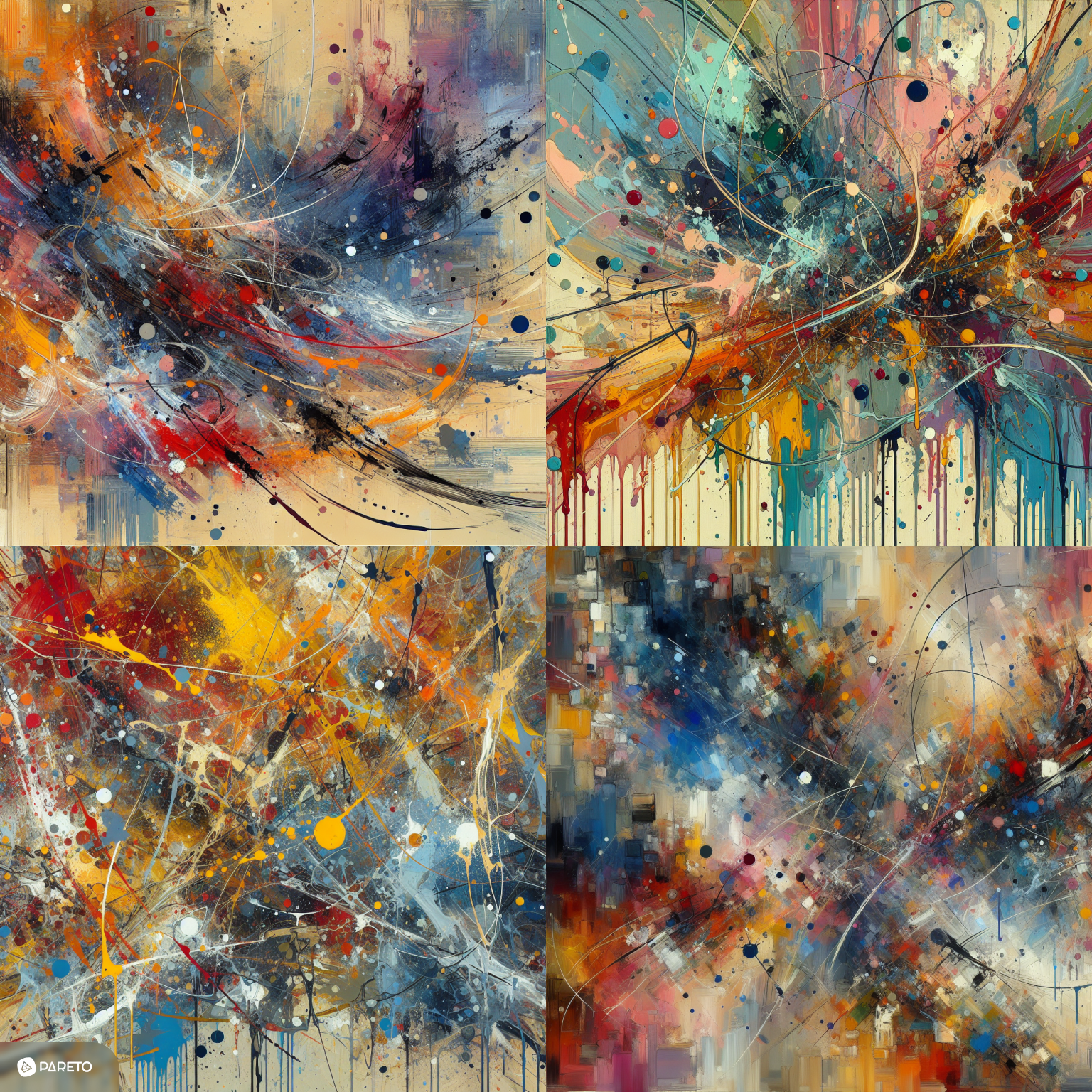
Prompt: "Abstract expressionist style, inspired by Jackson Pollock's iconic drip painting technique. Design a non-figurative composition that covers the entire canvas with a complex web of paint splashes, drops, and streaks. Use a variety of colors, including bold primaries and earth tones, layered and interwoven to create depth and visual interest. Brushstrokes should appear spontaneous and energetic, conveying a sense of movement and rhythm across the surface. Incorporate varying thicknesses of paint lines, from thin, delicate strands to thick, bold splatters. Make sure the composition doesn't have a clear focal point, allowing the viewer's eye to dance across the canvas. The overall effect should be dynamic and chaotic, but balanced in the distribution of colors and shapes".
Model: DALL-E 3
12. Gustav Klimt
Gustav Klimt, associated with the Art Nouveau movement, is known for his use of gold and ornamental patterns in his works. His style is characterized by symbolism, subtle eroticism and elaborate decoration.
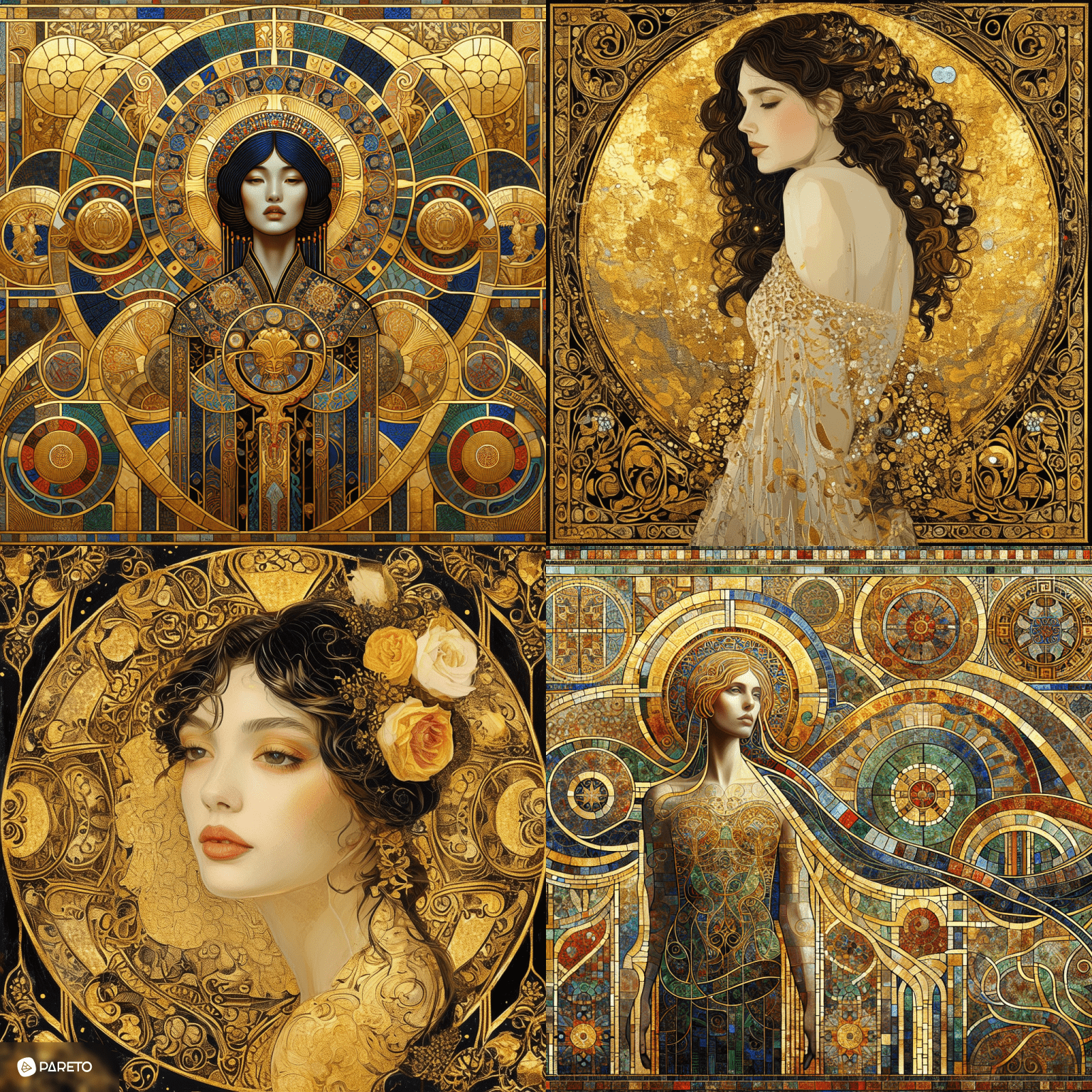
Prompt: "Inspired by Gustav Klimt's Art Nouveau style. Composition featuring a central female figure surrounded by elaborate ornamental patterns. Incorporate extensive use of gold leaf throughout the image, especially in the background and decorative elements. The figure should be represented in a more realistic style, contrasting with the abstract geometric patterns that surround her. Include intricate designs and mosaics inspired by Byzantine art. Use a rich color palette with deep reds, blues, and greens along with dominant golden tones. The overall composition should have a vertical emphasis.
Model: DALL-E 3
13. Wassily Kandinsky
Wassily Kandinsky, an abstractionist, was a pioneer of non-objective art. His works are characterized by geometric shapes, vibrant colors and an exploration of the relationship between music and painting.
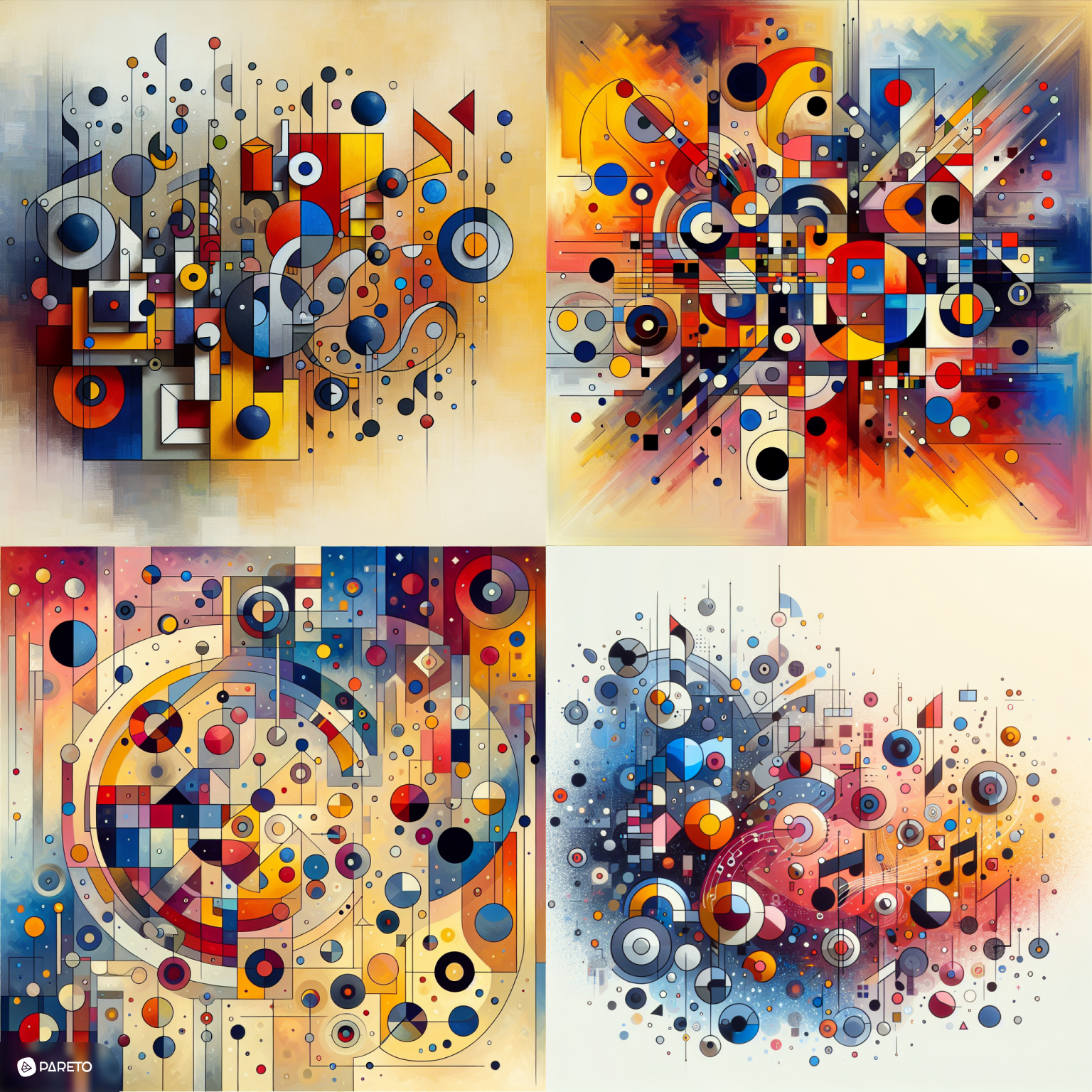
Prompt: "Abstract style. Inspired by Wassily Kandinsky's non-objective art. Floating icons. Compose a dynamic arrangement of geometric shapes such as circles, triangles, squares, and lines, floating in what seems to be an infinite space. Use a vibrant color palette with bold primary colors along with softer, more nuanced tones. Light background. Incorporate elements suggesting a musical quality, such as rhythmic patterns or shapes evoking musical notation or instruments. Aim to evoke a sense of synesthesia between visual art and music".
Model: DALL-E 3
14. Henri Matisse
Henri Matisse, a Fauvist and modernist, is known for his expressive use of color. His works are characterized by the simplification of forms, vivid colors and harmonious compositions.
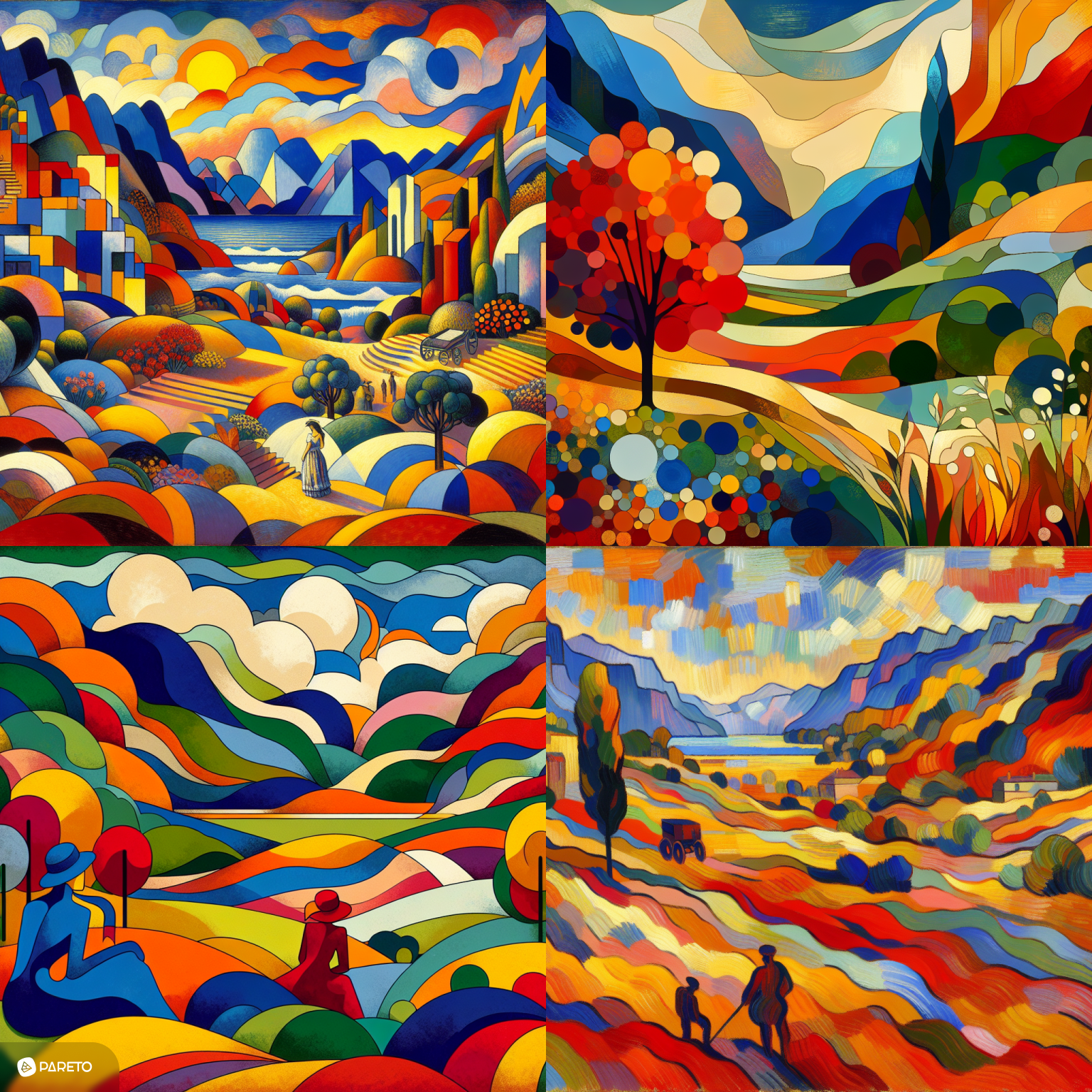
Prompt: "Inspired by Henri Matisse's fauvist and modernist style. Portray landscape. Use vibrant, non-naturalistic colors that convey emotion rather than reality, such as bright reds, intense blues, and bright yellows. Incorporate apartment areas of pure color with minimal shading or modeling. The scene should represent a harmonious arrangement of landscape and figure. Consider adding elements in Matisse's style, with organic shapes that appear pasted onto the background".
Model: DALL-E 3
15. Edvard Munch
Edvard Munch, an expressionist, is known for exploring psychological themes in his works. His works are characterized by intense emotions, distorted figures and symbolic use of color.
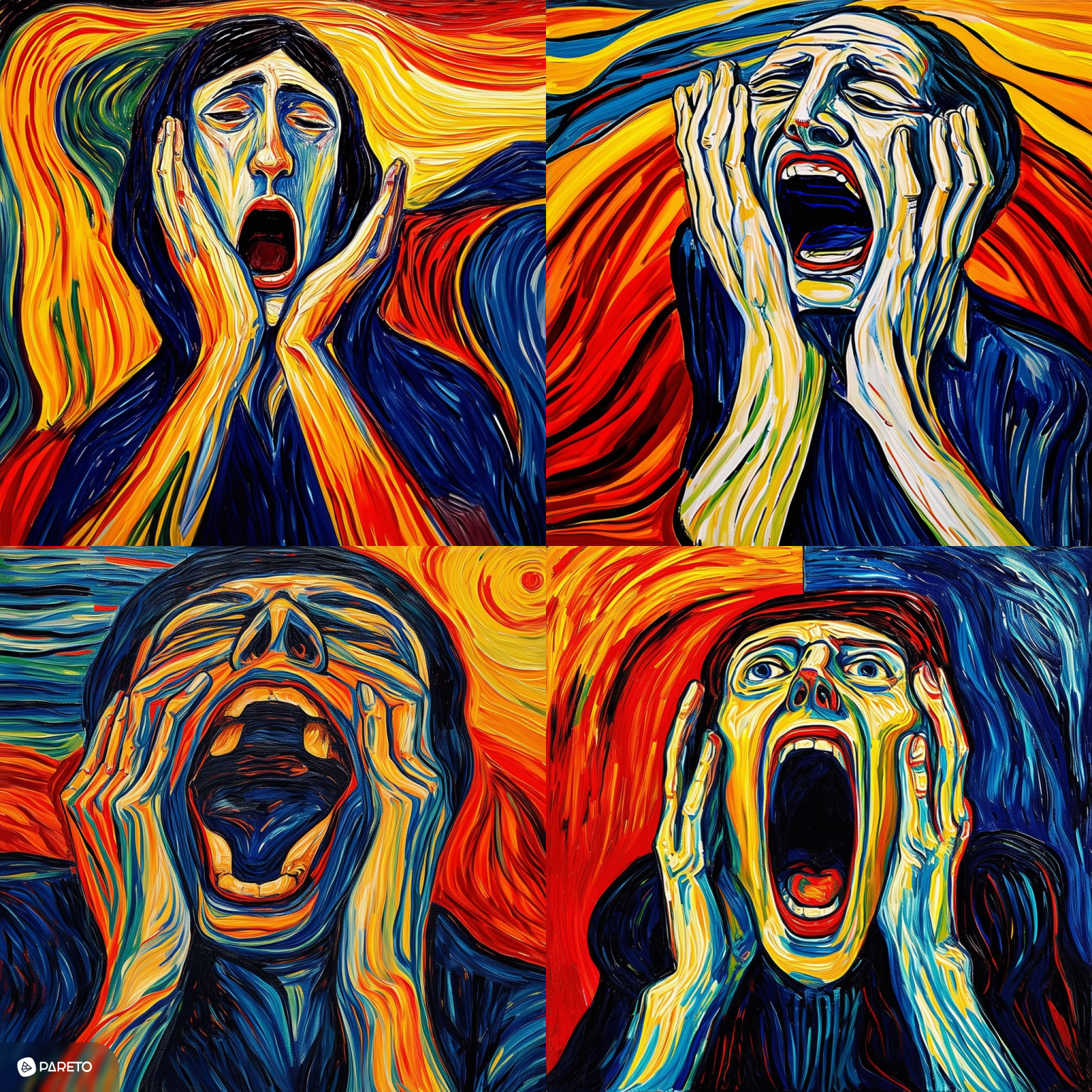
Prompt: "Expressionist style by Edvard Munch. Get inspired by the work "The Scream". Present the elongated and distorted central figure with hands on the face, mouth open, screaming. Composition that explores deep psychological themes, focusing on intense emotions such as anxiety, loneliness, or existential dread. Use wavy colored lines to represent emotional states: brown, blue, and green. Incorporate a background that reflects and amplifies the psychological atmosphere, such as a turbulent sky, just like in the work "The Scream".
Model: Stable Diffusion 3
Is AI a Risk to Artists' Work?
After seeing images made with AI inspired by different artists, it's natural to question whether human labor can be replaced in this field. However, computer-generated imagery is still a human artistic expression. Although it involves algorithms, these are developed based on human learning and creativity.
The final product comes from commands made by people, using their artistic vision and cultural knowledge. The works of the great masters serve as inspiration for AI to recreate the arts, but the creative essence and critical vision are entirely human.
Although AI can create impressive works in seconds, it lacks the introspection and social criticism that define human art. According to Francisco Barretto, a professor at UFBA and researcher in AI and computational creativity, the machine cannot replace the artist's critical eye on society and identity.
For Yaak, CEO of the startup Yaak Ventures, which specializes in tracking and securing digital works of art, AI is a powerful tool that can enrich artistic creation, but human creativity remains irreplaceable.
Source Artificial Intelligence is already recreating and making works of art, and what about artists? August 2023. Tilte UOL.
Conclusion
By exploring images made with AI inspired by different artists, we hope to have sparked your inspiration for new creative projects. The fusion between the artistic genius of the past and the infinite possibilities of modern technology opens up a world of opportunities for visual expression.
Along this journey through different styles and techniques, an intriguing question arises: does creativity really have limits? AI shows us that we can push our creative boundaries, blending classic techniques with digital innovation in ways that were previously unimaginable.
Don't be left behind in the digital revolution that is shaping the artistic and content landscape. Discover how Generative AI can boost creativity and automate your company's content, taking your visual expression to new heights of innovation and efficiency. Try Tess AI now, the Pareto AI.




